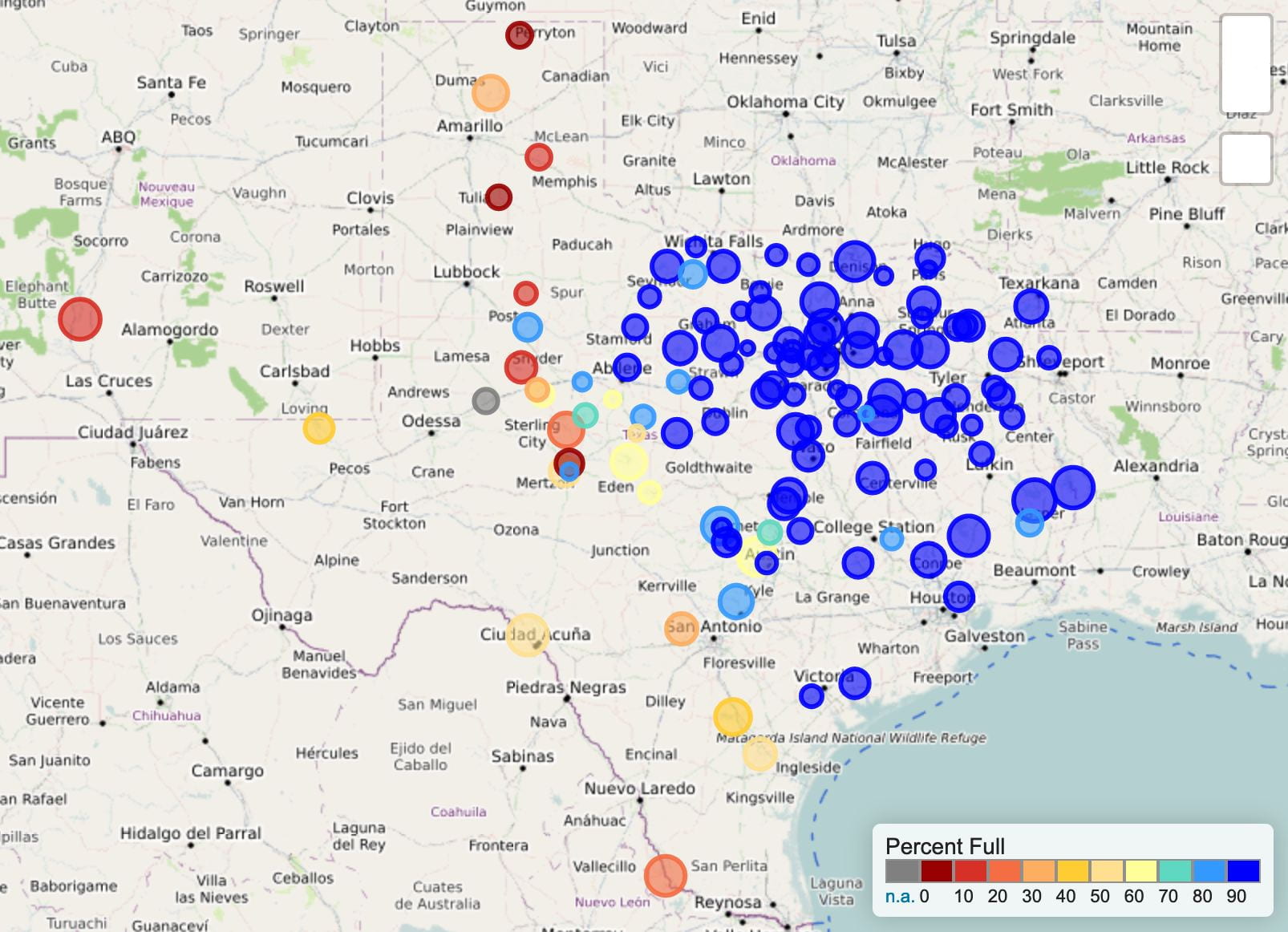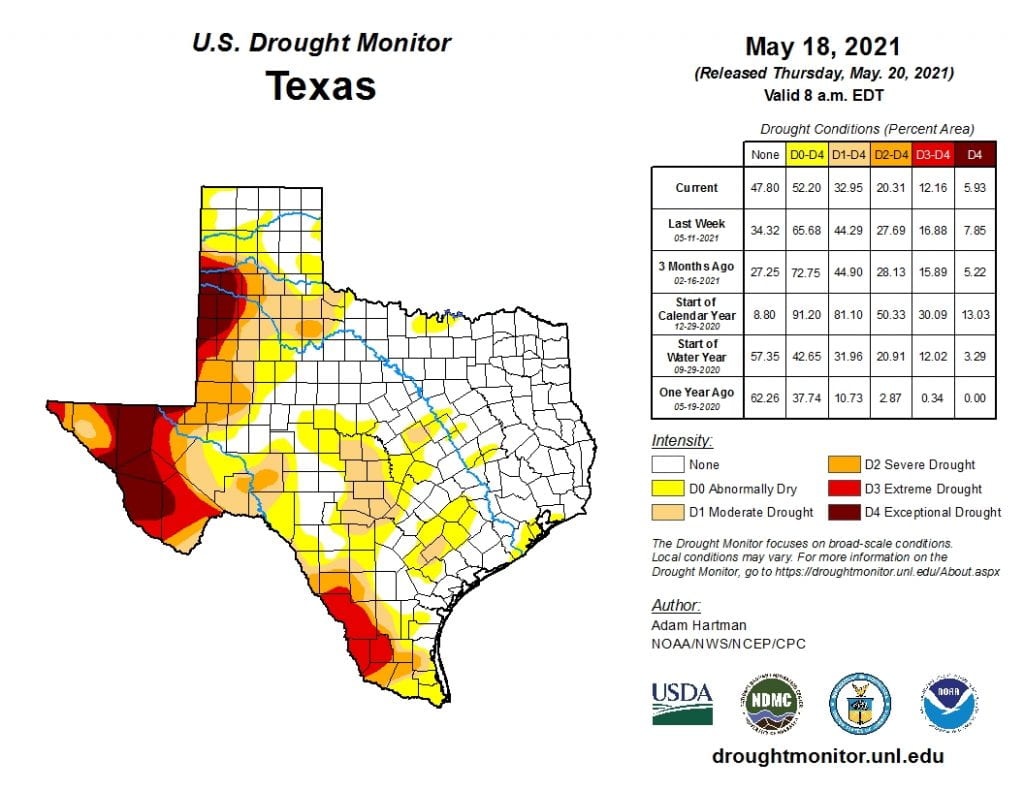SUMMARY:
- Six inches of rain over about half of the state reduced the amount of the state in drought by about 50 percent.
- La Niña has ended with neutral conditions expected to remain through the summer.
- The Climate Prediction Center projects 13 to 20 named storms, 6 to 10 hurricanes, and 3 to 5 major hurricanes for 2021 Atlantic hurricane season.
I wrote this article on May 21, 2021.
For most of you, if you’ve been outside lately, you’ve noticed something we haven’t seen in a bit (besides a Willie Nelson concert): rain!!! Big rains across much of the state have dramatically improved drought conditions, although much of the state is still seasonally behind on the wet stuff and parts of Far West Texas, the High Plains, and the Lower Rio Grande Valley are still suffering from extreme to exceptional drought.
The Climate Prediction Center released its first Atlantic Hurricane Season Outlook for 2021 on May 20 and projects 13 to 20 named storms, 6 to 10 hurricanes, and 3 to 5 major hurricanes (Figure 1). If accurate, this would be a busier-than-normal season, even with the upward adjusted numbers in response to greater storm activity. As if on cue, the first tropical disturbance of the season sprung up in the Gulf of Mexico with projections to hit Texas, but with only a 40 percent chance of becoming a storm at the time I wrote this.

Figure 1: 2021 Atlantic Hurricane Season Outlook for May (source).
Over the past 28 days, most of the state has been drenched with at least 2 inches of liquid gold, with most of the eastern half receiving at least 6 inches of Adam’s ale and a few spots (gulp) getting dowsed with more than 20 inches (Figure 2a). Unfortunately, the cloud tears somehow missed much of Trans-Pecos Texas, most of which received less than a quarter of an inch (Figure 2a). About four fifths of the state got more than its average amount of rain over the past 28 days, with much of the greater Big Bend area receiving 10 to 50 percent less than normal (Figure 2b). The rainfalls over the past month pulled much of state from a deficit into a surplus over the past 90 days, but much of the state remains at less than normal for this time period (Figure 2c).

Figure 2a: Inches of precipitation that fell in Texas in the 30 days before May 21, 2021 (source). Note that cooler colors indicate lower values and warmer indicate higher values.

Figure 2b: Rainfall as a percent of normal for the 30 days before May 21, 2021 (source).

Figure 2c: Rainfall as a percent of normal for the 90 days before May 21, 2021 (source).
The amount of the state under drought conditions (D1–D4) decreased from 67.1 percent four weeks ago to 33.0 percent at present (Figure 3a) with drought fading over much of the state (Figure 3b). Exceptional drought, the most intense drought category, remained focused on Far West Texas and the High Plains and decreased from 9.0 percent of the state four weeks ago to 5.9 percent at present (Figure 3a).
The rains removed Exceptional drought from the Lower Rio Grande Valley but only knocked it down one level to Extreme drought (Figure 3a). In all, 47.8 percent of the state remains abnormally dry or worse (D0–D4; Figure 3a), down considerably from 87.6 percent four weeks ago.

Figure 3a: Drought conditions in Texas according to the U.S. Drought Monitor (as of May 18, 2021; source).

Figure 3b: Changes in the U.S. Drought Monitor for Texas between April 20, 2021, and May 18, 2021 (source).
The North American Drought Monitor, which runs a month behind reality, continues to show a raging drought in much of the western United States, with Exceptional Drought entrenched in the American Southwest (Figure 4a). Precipitation in most of the Rio Grande watershed in Colorado and New Mexico over the last 90 days continues to be predominantly less than normal, although parts of the headwaters in Colorado received more than normal (Figure 4b). Conservation storage in Elephant Butte Reservoir increased from 11.3 percent full last month to 12.5 percent (Figure 4c), just above historic (since 1990) lows.
The Rio Conchos basin in Mexico, which confluences into the Rio Grande just above Presidio and is an important source of water to the lower part of the Rio Grande in Texas, is in Moderate to Severe drought conditions (Figure 4a). Combined conservation storage in Amistad and Falcon reservoirs remained the same as last month at 39.8 percent today, about 18 percentage points below normal for this time of year (Figure 4d).

Figure 4a: The North American Drought Monitor for April 30, 2021 (source).

Figure 4b: Percent of normal precipitation for Colorado and New Mexico for the 90 days before May 18, 2021 (source). The red line is the Rio Grande Basin. I use this map to see check precipitation trends in the headwaters of the Rio Grande in southern Colorado, the main source of water to Elephant Butte Reservoir downstream.

Figure 4c: Reservoir storage in Elephant Butte Reservoir since 2019 with the median, min, and max for measurements from 1990 through 2020 (source).

Figure 4d: Reservoir storage in Amistad and Falcon reservoirs since 2019 with the median, min, and max for measurements from 1990 through 2020 (source).
Recent rains alleviated low flows in many Texas basins, but there are still a half-dozen or so below the historical 25th percentiles (Figure 5a). Statewide reservoir storage is at 84.2 percent full as of today, up from 82.1 percent a month ago and slightly below normal for this time of year (Figure 5b). Most reservoirs in the eastern part of the state are now above 90 percent full (Figure 5c).

Figure 5a: Parts of the state with below-normal seven-day average streamflow as of May 21, 2021 (source).

Figure 5b: Statewide reservoir storage since 2019 compared to statistics (median, min, and max) for statewide storage from 1990 through 2020 (source).

Figure 5c: Reservoir storage as May 21, 2021 in the major reservoirs of the state (source).
Sea-surface temperatures in the Central Pacific that, in part, define the status of the El Niño Southern Oscillation, have continued their warming trend such that we are now out of La Niña conditions (Figure 6a). Projections of sea-surface temperatures remain above La Niña conditions through the summer with the possible return to La Niña conditions in early fall (Figure 6a). The jump in temperature projections in late fall and early winter appears to be an artifact reflecting uncertainty in projecting that far in the future and therefore seemingly defaults to neutral conditions. The Climate Prediction Center projects a 67 percent chance of neutral conditions holding through June–August (Figure 6b).

Figure 6a. Forecasts of sea-surface temperature anomalies for the Niño 3.4 Region as of April 19, 2021 (modified from source). “Range of model predictions -1” is the range of the various statistical and dynamical models’ projections minus the most outlying upper and lower projections.

Figure 6b. Probabilistic forecasts of El Niño, La Niña, and La Nada conditions (source).
The U.S. Seasonal Drought Outlook through August 31, 2021 projects drought persistence for the westernmost parts of Texas, with the removal or improvement of drought conditions in the blotchy bits of the rest of the state (Figure 7a). The three-month temperature outlook projects (scratches rear-end) warmer-than-normal conditions statewide (Figure 7b) while the three-month precipitation outlook slightly favors drier-than-normal conditions for the westernmost parts of the state and wetter-than-normal conditions in the Houston-Beaumont area (Figure 7c).

Figure 7a: The U.S. Seasonal Drought Outlook for May 20, 2021, through August 31, 2021 (source).

Figure 7b: Three-month temperature outlook from May 20, 2021 (source).

Figure 7c: Three-month precipitation outlook from May 20, 2021 (source).

